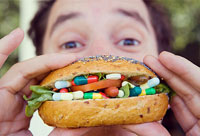Every Food-Making Company Has Its Own Cemetery of Customers
It is very hard to buy food without any additives today. Coloring agents, fillers, conservatives and other chemicals indicated as “E” with digits can be found in practically everything that we eat today. Where do they all come from and why do we have to eat those chemicals?

Food makers will not like the answer to this question. They are fond of making consumers believe that we all use food additives all the time: salt, sugar, soda, vinegar, etc. Indeed, sodium bicarbonate and vinegar are included on the list of additives as E500 and E260. All other E-additives – thousands of them – can not be found in our kitchens.
The massive use of additives with the E prefix was launched between the 18th and the 19th centuries, although their production was a crime. This chemistry became legal many years afterwards. It is an open secret that coloring agents make your food look a lot nicer. Red aniline dye or carmine from cochineal (made from green-flies) can be added to improve the color appearance of minced or chopped meat. This technology was described in a book published in 1907 in New York.
Afterwards, the chemicals were described as food additives. Aniline dyes were banned for posing health hazard, whereas cochineal – a substance made from bugs – is still used. The chemical industry produced thousands of other substances to give sausage products a nice meat color instead of their natural grey.
Starch is also used during the production of sausages. It is used as a filler to inhibit water and supersede expensive meat. The use of starch makes the production technology cheaper, whereas the final product looks very nice and edible. Nowadays, the food industry uses genetically modified starch for it triggers a much better reaction in the production of sausage products. Stabilizers, vegetable albumens and the albumens made of processed inedible parts of animals and birds work a lot better with genetically modified starch. All these chemicals reduce the price and produce the effect of meat of the virtually meatless product.
In the past, makers of candy would often add dangerous substances in the products made for children. For example, they used coloring agents containing copper and lead. It was even rumored that every food maker, like every surgeon, had their own cemeteries.
It is hard to believe these stories, but one may recollect the recent scandal with toxic melamine added in baby food in China. Formaldehyde, a highly toxic and carcinogenic substance produced from melamine, had been used as a food conservative for years. Moreover, the E239 additive – hexamethylenetetramine – which turns into formaldehyde – is still legally allowed in Russia. It is used as a conservative for fish and caviar.
They tried to establish control over the production of food in the beginning of the 20th century. It became clear that it was already impossible to root out falsified food. Officials had to conduct complicated talks with food makers to legalize many chemicals used in their recipes.
The control over the use of additives in the food industry was launched during the 1950s, when the UN established a special department of food and health experts. Some chemicals were banned after a series of poisonings and deaths. The most outstanding scandal at this point is connected with the use of cobalt-containing additives. They would make beer foam nice and puffy but trigger the development of a serious heart disease with beer fans. Numerous deaths were reported during 1964-1966 in Belgium, the USA and Canada. The cobalt-containing additives were quickly banned.
The most recent scandal is connected with six synthetic coloring agents for sweets and drinks produced for children. The agents develop the syndrome of hyperactivity. EU officials decided not to ban the chemicals, but simply asked food-making companies to stop using them and change their recipes. It means that the European makers will be making safe and high-quality candy in Europe, but export dangerous products where the additives are legally allowed.
In conclusion, we would like to remind you that the tests of food additives are imperfect. Many of them are considered harmless only relatively. They are legally allowed only temporarily.
Arguments and Facts
Subscribe to Pravda.Ru Telegram channel, Facebook, RSS!





